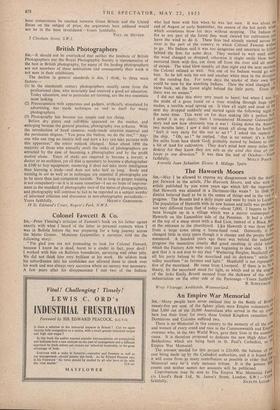The Haworth Moors
SIR,—May I be allowed to express my disagreement with the the°rY put forward in the article, The Haworth Moors, and also with an article published by you some years ago which left the impression that Haworth was situated in a Dartmoor-like waste ? In 1848 III district believed itself to be in the centre of things and in the van `1 progress. The Brontës had a daily paper and went by train to London' The population of Haworth with its new houses and mills was probably' not very different from that of today—about 7,000. I happen to hal been brought up in a village which was a mirror counterpart 0,` Haworth on the Lancashire side of the Pennines. It had a churthr at the top of a steep street with a Red Lion, instead of a Black Bull' at the entrance to the churchyard. Like Haworth it was three Mile; from a large town along a house-lined road. Outwardly it ila: changed little in sixty years though it is cleaner and the people mannered. A hundred years ago there was behind the industrial progress the insensitive cruelty Ihd greed resulting in child labonr which the Factory Acts were only just beginning to deal with. I sot! gest that it is not true to say that " Wuthering Heights, Heathcliff and all his party belong to the moorland and its darkness " while iho valley manifests " its fairness and light." Heathcliff is not represent"' tive of the moorland. He came from Liverpool. If there is to b' theory, let the moorland stand for light, to which and to the singin,', of the larks Emily Brontë escaped from the darkness. of the crlw industrialism on the other side of the Parsonage.—Yours faithfully'' Wray Vicarage, Ambleside, Westmorland.
B. SCHOLFIELV.


































 Previous page
Previous page